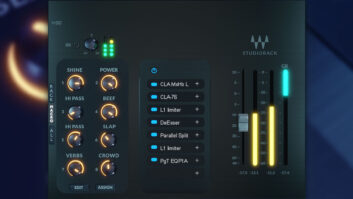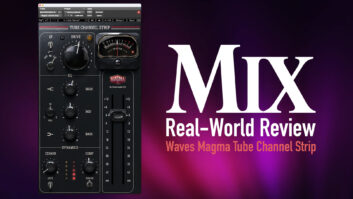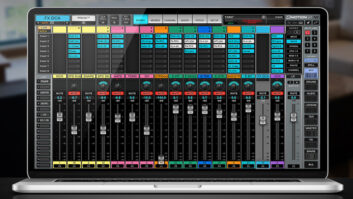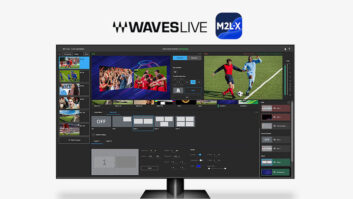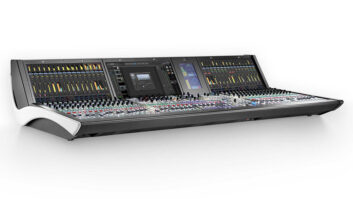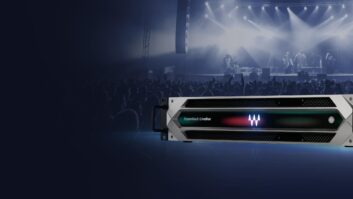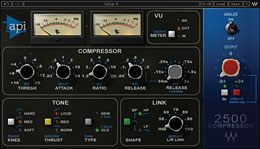

Waves and Automated Processed Inc. (API) have co-engineered the API Collection of plug-in processors based on the latter’s hardware processors. The API Collection bundles four plug-in processors: 550A 3-band EQ, 550B 4-band EQ, 560 10-band graphical EQ and the 2500 stereo compressor. The processors are carefully modeled in stereo and mono versions using 48-bit double-precision math, and they operate at up to 96 kHz, except the 560, which goes up to 192 kHz. They are available in native ($1,000) and TDM ($2,000) versions; iLok authorization is required.
A SIMPLE GUI
The API 2500 stereo compressor plug-in has separate threshold, attack, release and ratio controls.
Each of the four plug-ins is encased in a virtual anodized-blue Series 500 Lunchbox with a large output level control. A pair of large VU meters dominates the GUI; even the mono versions of the EQs have two meters, both showing output level. Unlike the original hardware units, the plug-in offers an I/O clip indicator, polarity “flip” switch and an Analog on/off switch. The Analog feature can engage or bypass the modeling of the hardware’s processor noise and harmonic distortion. With Analog on, these plug-ins sound so close to the originals it’s scary, so I chose to do all my testing with Analog enabled. As with all Waves plug-ins, the included WaveSystem toolbar manages user and factory presets with 32 levels of undo/redo, preset A/B’ing and recall/save/load functions.
BRING ON THE EQUALIZERS
The plug-ins model the signature sound of the compact API 550A, 550B and 560 hardware EQs, which is due to the proportionate-Q circuit design and API’s discrete 2520 Class-A/B operational amplifier module. Applying more boost/cut sharpens the Q, offering a more aggressive sound. The boost and cut curves are reciprocal — you can easily reverse an equalizer setting used in a recording by applying an equal but opposite amount of boost/cut. This is as close as it gets to an Undo button in an analog unit.
The 550A offers five frequency choices across three overlapping bands. The high and low bands are switchable from peaking to shelving filters. The plug-in also models the independent 50 to 15k Hz bandpass filter that’s only available on the 550A. The 550B offers seven frequency choices for each of its four overlapping band sections. Again, the high and low bands are peak/shelving-switchable.
The 560 graphic EQ has 10 frequency bands, spaced one octave apart with ±12dB boost/cut. A graphical EQ with proportionate Q means that just touching a frequency band with a small boost or cut makes a very subtle change. However, moving the fader up by more than one-third begins carving more deeply.
The equalizers each have a Trim window, which, as your audio plays, displays the highest peak signal level for that track over time. When Trim shows the top level to be 1.5 dB, another 1.4 dB of headroom remains before clip. If you click on Trim, it will reset the highest peak to be at -0.1 dBFS. This is a great feature for maximizing gain structure in a channel strip’s signal chain.

The 550 EQs are capable of subtle and radical equalization.
A LOOK AT THE 2500
Like the hardware unit, the API 2500 stereo compressor plug-in has separate threshold, attack, release, ratio, and fixed- and variable-release controls. Unique to the 2500 are the compressor Tone section and comprehensive stereo linking. The Tone section offers hard, medium and soft-knee compression options; the patented Thrust detector filter circuit; and a choice between two compressor-detector signal derivation topologies: old-style feedback or the more modern feed-forward method.
Choosing between hard, medium or soft-knee compression configures the 2500 for the desired compression task — anywhere between aggressively controlled and noticeable to gentle, smooth and subtle. Thrust inserts any of three different filters before the compressor’s RMS detector. Normal position is flat; Med decreases the energy in the low frequencies and slightly boosts the high frequencies; and Loud decreases even more lows and adds more highs to the detector’s input.
The L/R linking system sends a mix of the left and right channels’ level contributions to the left and right channel detectors. You can set the “depth” of linkage from none — or 0 percent — for dual-mono setups to 50, 60, 70, 80, 90 or 100-percent linked. The Link control signal can be shaped using a three-position filter: highpass, lowpass or both together for a bandpass filter.
Waves has accurately modeled the 2500’s Auto-Make-Up gain; it maintains the same output level without regard to changes made to threshold or ratio — a great feature for “on-the-fly” adjustment.
ON TRACK WITH API
I tested the API Collection in a Pro Tools Accel HD3 rig running on a quad-core Mac. I started using the 550A as if I were engineering on a real API desk. The 550A’s low latency and low DSP usage make it ideal to use across your mixer as a main EQ for vocals, guitars, keyboards or program. On guitars, the Trim feature helped to maximize the channel strip for the wide dynamics of a wah-wah part, but a simple input trim control (similar to that on Waves’ SSL channel strip plug-in) would have saved me the trouble of adding a DigiRack Trim plug-in to keep an over-recorded track (in the red) from overloading the EQ.
On the 550A and 550B, the amount of boost/cut (2/4/6/9/12 dB) changes to yellow to verify that you’ve selected it — a nice touch. I recorded vocals through the 550B with no trouble at all. A smooth boost at 5 kHz and 12.5 kHz was just what my singer needed when using a Neumann U47.
The 550A and -B provide subtle EQ until the boost/cut knob goes beyond 4 dB. The 550A worked with just about any track, but if I needed a fourth frequency the 550B came to the rescue. Most individual tracks benefit from a little EQ, and subtle ±2 dB here and there can make a big difference in the overall sound. Like the hardware 550A, winding up to +9 dB at 10 kHz on a vocal track will open up the air and ambience to recover from the dulling effect of a compressor that’s ahead in the chain, but beware of sibilance.
The 560 graphic EQ went to work on all my drum tracks. Whether you’re adding point and boom to kicks, carving out something useful from a dumpy old snare drum or dialing in tom-toms, this is the one! Good thing the output level control lowered the level-off clip when I pushed excessive 8 kHz on a side-stick sample. On kick drums, I thinned out the 500Hz area and boosted the frequencies an octave down to get more kick drum presence and a better “marriage” with the bass guitar.
THE 2500 ON MY MIX
I did extensive A/B’ing between the 2500 and Waves’ other stereo bus compressor, the SSL Compressor. On the SSL, I normally use only about 3 dB or less of max compression at 4:1. I use this technique for the slight level jump and the way it colors and enhances my mixes’ bottom end. Set the same way, the 2500 excels over the SSL whenever I’m after a more crushed sound. With all the ways you can program this compressor, creating specific combinations of the knee, thrust and feedback/feed-forward settings, the 2500 provides more punch and clarity when it’s pushed hard.
For stereo mixes, I found myself using the Med Thrust and Knee positions most often — changing to Loud Thrust necessitates resetting threshold and/or output level. I don’t use stereo linking because it always narrows the stereo width in my mixes — but then I never put superloud “events” on one side only, which might shift the center image.
Available for both Mac and PC platforms, this bundle is a serious asset to DAW studio users. These plug-ins are as invaluable as a rack of outboard gear is in analog studios.
Waves, 865/909-9200, www.waves.com.
Barry Rudolph is an L.A.-based recording engineer. Visit him online at
www.barryrudolph.com.

READ: More information on the Waves API Collection
550A Bands and Frequencies
Low-Band Gain
Range: -12 dB to +12 dB (2 to 3dB steps)
Low-Band Frequencies
Filter Types: shelf, bell
50Hz, 100Hz, 200Hz, 300Hz, 400Hz
Mid-Band Gain
Range: -12 dB to +12 dB (2 to 3dB steps)
Mid-Band Frequencies
Filter Type: bell
400Hz, 800Hz, 1.5kHz, 3kHz, 5kHz
High-Band Gain
Range: -12 dB to +12 dB (2 to 3dB steps)
High-Band Frequency
Filter Types: shelf, bell
5kHz, 7kHz, 1okHz, 12.5kHz, 15kHz
Bandpass Filter
50 to 15k Hz
550B Bands and Frequencies
Low-Band Gain
Range: -12 dB to +12 dB (2 to 3dB steps)
30Hz, 40Hz, 50Hz, 100Hz, 200Hz, 300Hz, 400Hz
Low Mid-Band Gain
Range: -12 dB to +12 dB (2 to 3dB steps)
75Hz, 150Hz, 180Hz, 240Hz, 500Hz, 700Hz, 1kHz
High Mid-Band Gain
Range: -12 dB to +12 dB (2 to 3dB steps)
800Hz, 1.5kHz, 3kHz, 5kHz, 8kHz, 10kHz, 12.5kHz
High-Band Gain
Range: -12 dB to +12 dB (2 to 3dB steps)
High-Band Frequency
Filter Types: shelf, bell
2.5kHz, 5kHz, 7kHz, 10kHz, 12.5kHz, 15kHz, 20kHz
560 Graphic Bands and Frequencies
Gain
Range: -12 dB to +12 dB
31Hz, 63Hz, 125Hz, 250Hz, 500Hz, 1kHz, 2kHz, 4kHz, 8kHz , 16kHz
Small header: 2500 Stereo Compressor
Threshold Range
+10 dBu to -20 dBu
Attack Times
0.03 ms, 0.1 ms, 0.3 ms, 1 ms, 3 ms, 10 ms, 30 ms
Release Times
0.05 sec, 0.1 sec, 0.2 sec, 0.5 sec, 1 sec. 2 sec, variable
Ratios Available
1.5:1. 2:1, 3:1, 4:1, 6:1, 10:1, Infinity:1
L/R Link
Dual Mono, 50%, 60%, 70%, 80%, 90%, 100%
TDM DSP Usage/Latency
Pro Tools Version 7.3.1cs3 Accel HD3, Mac Quadcore, 4.5GB RAM
550A mono
21 percent of chip for each instance—5 to Chip—3 samples
550A stereo
38 percent of chip for each instance—2 to Chip—3 samples
550B mono
21 percent of chip for each instance—5 to Chip—3 samples
550B stereo
38 percent of chip for each instance—2 to Chip—3 samples
560 mono
53 percent of chip for each instance, 68 samples
560 stereo
100 percent of chip for each instance, 68 samples
2500 mono
21 percent of chip for each instance—4 to Chip—3 samples
2500 stereo
48 percent of chip for each instance—2 to Chip—3 samples

